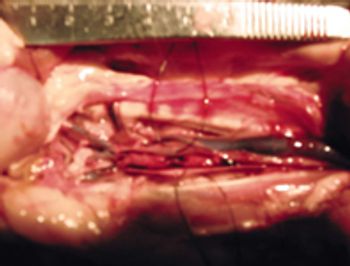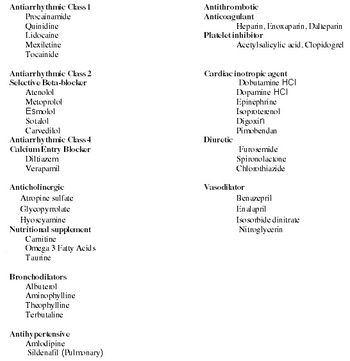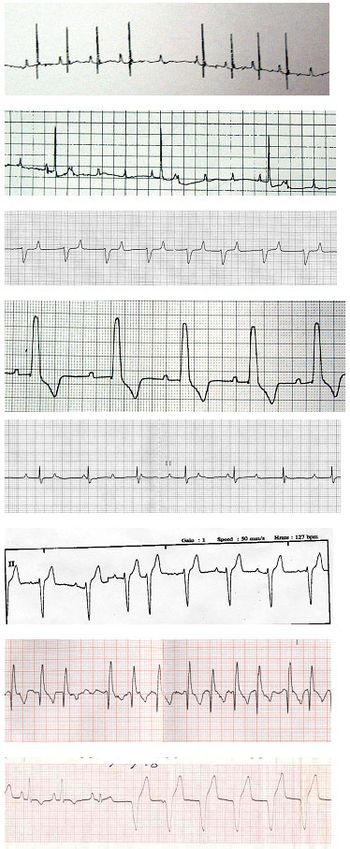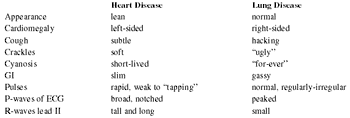
Thromboembolism is a fairly common and potentially devastating complication of heart disease in cats.

Thromboembolism is a fairly common and potentially devastating complication of heart disease in cats.

The patient suspected of having a cardiac problem needs to have a complete history taken and physical examination performed; these procedures will establish the correct diagnosis and permit appropriate therapy. The cardiac examination is an extension of the complete physical examination.

Determine age, breed, and sex of the patient to help formulate a rule-out list and help to determine prognosis. Note current pre-existing diseases. Record current drugs and clinical response. Record presenting clinical signs and duration and progression of the illness.

Electrocardiography is an integral part of the cardiological exam. It is the only way to determine heart rhythm accurately and to determine if there are any conduction abnormalities. This is also the most useful part of an ECG. ECGs can do other things however, these are not nearly as important.

I'll review the pathophysiological changes associated with the common congenital and acquired cardiac defects in small animal medicine and discuss the characteristics of anesthetic drugs that may make them desirable of undesirable for each problem.

Chronic heart failure (CHF) traditional therapy (for CHF secondary to chronic degenerative valvular disease etc.) still provides only an average a 4-6 months survival time in dogs. Though current standard treatment regimens provide a good quality of life for many canine patients, complications can lead to early patient loss.

The essentials of electrocardiography include the assessment of heart rate, heart rhythm, and the P-QRS-T waveforms. The ECG is needed to accurately diagnose cardiac arrhythmias, and this test is extremely sensitive for this purpose.

Advancing technology has provided clinicians with ever more powerful and effective drugs for treating diseases. As more drugs become available, it becomes progressively more difficult to be aware of the numerous side effects, contraindications, and drug interactions of the many cardiopulmonary drugs available.

ECG case studies.

The clinical signs of canine and feline heart failure are limited, but they must be distinguished from pulmonary dysfunction and also systemic problems. Heart disease often results in secondary respiratory signs (e.g., coughing or dyspnea); conversely, disease of the lung or its vasculature can result in secondary right heart disease (e.g., cor pulmonale).

Help for diagnosing and treating chronic valvular heart disease in dogs.

A critical aspect of treatment in the late stages of the disease.

Technicians familiar with cardiac emergencies can respond quickly and appropriately to minimize suffering and maximize the chance of success of treatment for the patient.

Congenital cardiac defects are those present at birth, and are most often from a genetic cause. In addition to genetic causes, they can also be from infectious, environmental, pharmaceutical, or a variety of causes.

Proper electrocardiography (ECG) starts with proper positioning. For a diagnostic ECG, the patient must be restrained in right lateral recumbency with the legs perpendicular to the body and parallel to each other.

Veterinary technicians are the veterinary hospital's mainstay when it comes to carefully and successfully anesthetizing critical patients. A large number of elderly canine and feline patients are affected by cardiac disease, and knowledge of how to safely monitor, anesthetize, and problem solve cardiac patients makes for a less stressful anesthesia for both the patient and technician.

Common acquired cardiac diseases of the dog include those that are caused by valvular defects, myocardial failure, infectious reasons, as a result of arrhythmias, and parasitism.

Sustained hypotension is a life threatening situation where the body's major organs (kidney, liver, brain, and heart) can experience irreversible damage from inadequate perfusion pressure. Veterinary technicians may encounter hypotension frequently when caring for emergency and critical care patients, as well as anesthetized or post operative patients who are frequently at risk of systemic hypotension.

In this session we will review thoracic radiology and echocardiography with an emphasis on normal and abnormal anatomic features.

The objectives of this presentation will be to discuss treatment of heart disease in clinical cases.

The client wants to know, and will pay for, each test you perform or each drug you give, that has a reasonable expectation of making their pet feel better or live longer.

Cardiopulmonary interactions occur because both systems occupy space in the confined thoracic cage, because the heart pumps blood through and sucks blood from the lungs, and because the lungs hinder the flow of blood from right ventricle to left ventricle. Diseases of both systems share many signs/symptoms (e.g., cough, cyanosis, cardiomegaly, exercise intolerance) but fortunately disease of each system possesses a unique set of signs/symptoms.

Our patient population has changed fairly dramatically in the last 10 years as our medical skills have progressed and we have become capable of supporting patients with advanced disease and advancing age. Now we must hone our anesthesia skills in order to support patients that largely don't fit into the 'young, healthy' category and it is no longer appropriate to think that safe anesthesia means recovering as many patients as we anesthetize.

In cytology, cells that are properly smeared and stained can be described as "fried eggs" because of the similarity in the appearance of the nucleus and cytoplasm to the egg yolk and white. If the preparation is too thick, or is improperly stained, the cell outline may be seen, but intracellular detail will not be visible.

This session will focus on the three forms of feline cardiomyopathies: hypertrophic, dilated and restrictive. We will also discuss thromboembolic disease.